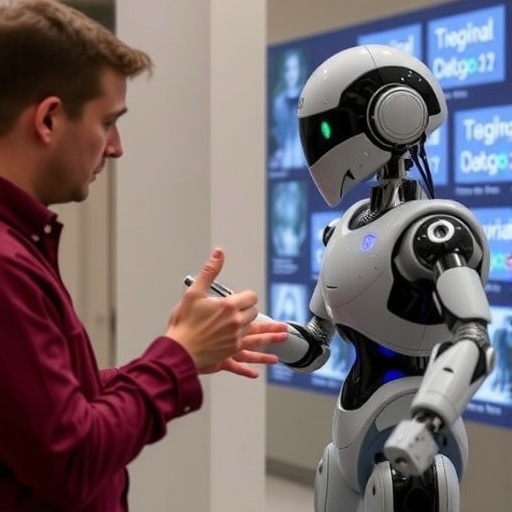In a remarkable advancement in robotic capabilities, researchers at UC Berkeley have developed an innovative AI-driven training methodology aimed at enabling robots to master exceedingly complex tasks with unmatched precision. This breakthrough comes from the team led by Sergey Levine, situated at the Robotics AI and Learning Lab. The research presents a significant leap forward in how robotics and artificial intelligence can be integrated to achieve practical applications in real-world scenarios.
At the heart of this pioneering work is a new training system named Human-in-the-Loop Sample Efficient Robotic Reinforcement Learning (HiL-SERL). This system represents a dual approach that combines traditional reinforcement learning with human feedback. Reinforcement learning, a subfield of machine learning, hinges on the notion that machines can learn effectively from trial and error. Robots, in this framework, engage in real-world tasks, receiving signals from their environment to inform successful actions. By analyzing their performance over time, they can refine their techniques to achieve mastery.
One notable demonstration involved a robot executing the intricate task of Jenga whipping, a challenge that perplexes even adept humans. This task specifically entails using a whip to dislodge a single block from a precariously stacked tower without disturbing its structural integrity. The robot’s ability to consistently succeed, reinforcing its learning protocol, showcases the potential of what HiL-SERL can achieve. First author Jianlan Luo, a postdoctoral researcher on the project, described his incredulity upon witnessing the robot’s first successful attempt. Luo attempted the same with a whip and acknowledged his zero success rate, highlighting the advanced proficiency that the robotic system has achieved.
The implications extend far beyond the confines of playful challenges like Jenga. The research emphasizes practical applications, reflecting the need for robots that can adapt and learn in environments that are often unpredictable and complex. This capability is increasingly essential as industries move towards automation and complex manufacturing processes. The proficiency in executing refined tasks, such as assembling computer motherboards or constructing automotive parts, demonstrates the versatility that HiL-SERL offers.
Through this method, the integration of human feedback allows for a significant acceleration in the learning curve of robots. Initial training involves a human operator correcting their actions, guiding the robot as it learns by integrating corrections into its memory. Over time, the dependence on human guidance diminishes as the robot’s experience accumulates, illustrating a streamlined path to autonomy.
This approach also extends to a variety of related tasks. The team subjected the robot to a suite of challenging activities that included flipping an egg, passing objects between its limbs, and comprehensive assembly operations. These tasks, chosen for their inherent complexity and variability, underscore how well the robots can adapt to different circumstances. By simulating potential mishaps—like dropping an object or adjusting to unexpected movements—the researchers train the robots to respond adeptly in dynamic environments, a critical trait for any practical application in the real world.
The reported results, with a successful execution rate of 100% by the end of the training trials, establish HiL-SERL as a leading-edge methodology. The performance of the robots was benchmarked against traditional behavioral cloning methods, which involve replicating demonstrated actions without the underlying adaptive learning process incorporated in HiL-SERL. The marked improvement in speed and accuracy over behavioral cloning illustrates the future trajectory in robotics training that could redefine industry standards.
As manufacturing demands grow, there is a burgeoning need for robots capable of handling a diverse array of tasks dynamically and consistently, particularly in sectors such as electronics and automotive manufacturing where precision is paramount. The recent advancements showcased by the researchers at UC Berkeley reaffirm that the capabilities of robotic systems can be not only enhanced but efficiently developed through innovative training paradigms.
The forward-thinking vision of this research does not stop here. Future endeavors aim to enhance the foundational capabilities of these robotic systems. Pre-training methods that establish basic object handling abilities could pave the way for robots to advance more directly into complex skill acquisition, promoting a quicker and more effective learning trajectory.
To facilitate broader access to this technology, the UC Berkeley team has made their research available as open-source. This strategic move is envisaged to foster collaborative advancements and expedite the integration of HiL-SERL into various robotics applications. Luo emphasizes the importance of accessibility, aiming for user-friendliness akin to everyday technologies.
The ultimate aim of these advancements lies in creating adaptable, reliable robotics solutions that can operate seamlessly in various domains, from intricate manufacturing lines to daily consumer applications. As robotics technology continues to evolve alongside AI, the possibilities appear virtually limitless, heralding a new era where robots do not merely assist but actively enhance human capabilities.
These innovative strides by the UC Berkeley team not only reflect the evolution of robotic competencies but also signify a transformative moment in the operational dynamics of machine learning and human assistance. In an increasingly automated world, such developments mark how artificial intelligence could redefine the workplace and everyday life, making previously unfeasible tasks not only achievable but efficient.
Researchers intend to continually refine their methodology and improve robotic learning systems, ensuring that advancements keep pace with the evolving demands of both industries and consumers. The commitment to open-source dissemination of their findings suggests a collaborative approach in tackling the challenges inherent in robotic learning and application.
As we look forward to future developments, the interplay between human guidance and robotic learning heralds a sophisticated frontier in technology—one that promises to reshape the very essence of work and interaction across diverse fields. The interplay of these elements will undoubtedly continue to influence the trajectory of robotics, paving the way for an intelligent future where machines learn, adapt, and thrive alongside human operators.
Subject of Research: Robotics and AI Training Methodologies
Article Title: Precise and Dexterous Robotic Manipulation via Human-in-the-Loop Reinforcement Learning
News Publication Date: 20-Aug-2025
Web References: Journal link
References: Not applicable
Image Credits: Courtesy of the Robotics AI and Learning Lab
Keywords
Robotics, AI, Reinforcement Learning, Human-in-the-Loop, Robotics Training, UC Berkeley, Automation, Machine Learning, Jenga, Dexterous Manipulation.




